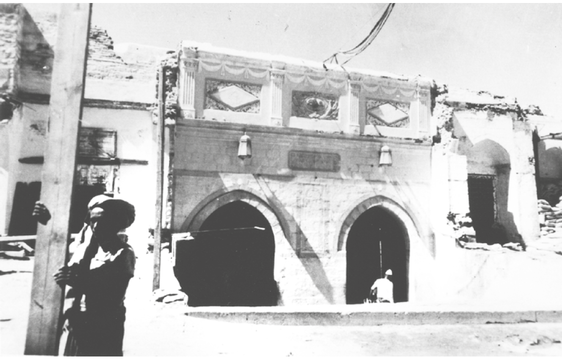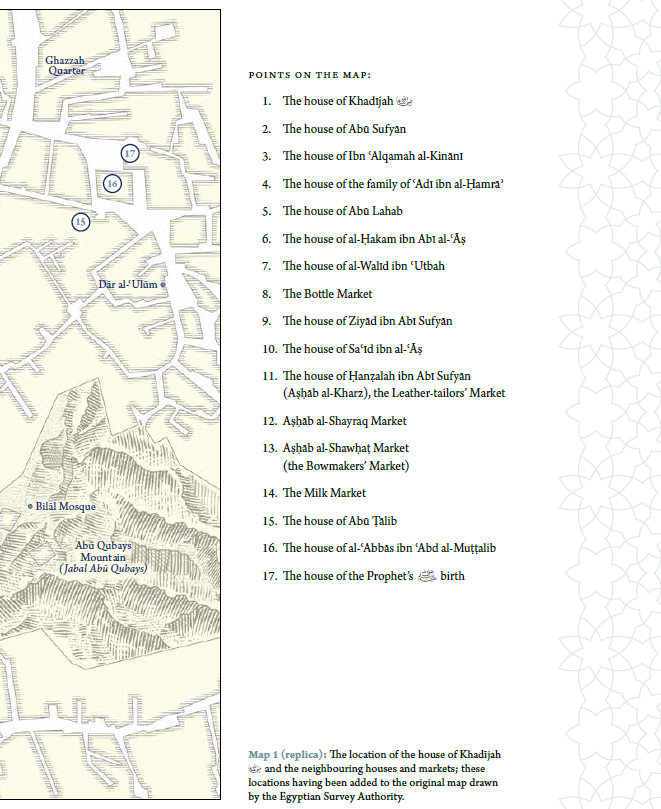Makkah was first divided into neighbourhoods during the time of Qušayy ibn Kilāb. When he became the leader of Makkah, following the rule of Khuzā‘ah, he gathered Quraysh together and divided Makkah into neighbourhoods, sharing them amongst the tribes. Each tribe built houses in the neighbourhoods it had been allotted. After the time of Qušayy, the tribes took it upon themselves to plan their dwellings. They would build homes for themselves and for their allies, or alternatively trade with the land, even outside their own allocated areas.1
When dividing Makkah in this way, Qušayy took for himself an area directly in front of the Ka‘bah, where he built Dār al-Nadwah, the consultative assembly building. He gave the area called Ajyādīn to the tribe of Banū Makhzūm, Masfalah to Banū Jumaħ, and al-Thaniyyah (nowadays al-Shabīkah) to Banū Sahm. He then divided the rest of Makkah amongst the other tribes.2
Al-Fākihī states:
“Ibn Abī Salamah told us, from ‘Abd al-Jabbār ibn Sa‘īd from Abū Bakr al-‘Ā’idhī from Sa‘īd ibn Muħammad ibn Jubayr ibn Muŧ‘im from his father from his grandfather, who said: ‘The site of this house of ours in Makkah was assigned to us by Qušayy ibn Kilāb, as were all of the houses of Quraysh in Makkah.’
Sufyān ibn ‘Uyaynah stated, as is narrated from him, that: ‘People inhabited Makkah in accordance with their nobility. So the clan of ‘Abd Manāf took the area facing the Ka‘bah, and al-Masīl, and al-Radm up to al-Mu‘allāh.’ He also said: ‘Quraysh continued to own and sell their land in Makkah until Islam came, while they were still occupying their same dwellings. When the Messenger of God ﷺ entered Makkah at the time of the conquest, he stood up and spoke to the people and he affirmed their ownership of their current areas and dwellings. Out of his kindness and forgiveness, he did not remove anyone from his area or from his house. Islam continued to confirm this state of affairs, as is seen after the conquest, when Šafwān ibn Umayyah came to Madinah asking to migrate there; the Prophet ﷺ said to him: ‘Go back to al-Abŧaħ, Abū Wahb; retain your homes3.’”
The quarter that Qušayy ibn Kilāb assigned to the clan of Banū Asad ibn ‘Abd al-‘Uzzā was in a special place in Makkah. Some of their houses were near to the western side of the blessed Ka‘bah. Amongst them was the house of Ħumayd ibn Zuhayr, which was directly behind it, and so close to it that it could sit in its shade, and vice versa. This house was subsequently donated to the Ka‘bah. Another was the house of Asad ibn ‘Abd al-‘Uzzā, which faced the west side of the Ka‘bah at only a few cubits distance. At the time, the house was called ‘the baby of the Ka‘bah’, until ‘Umar ibn al-Khaŧŧāb made it a part of the Sacred Mosque. Standing on al- Ħizāmiyyah Road, to the south west of the mosque, were the house of Ħakīm ibn Ħizām, the house of al-Zubayr, and also al-Zanj House and al-Bukht House, both of which belonged to al-Zubayr too. The latter of these stood between Dār al-Nadwah and al-‘Ajalah House. Here also were houses belonging to al-Zubayr’s sons Muš‘ab and al-Mundhir. Also lining al-Ħizāmiyyah Road, near to the house of Ħakīm ibn Ħizām was a house belonging to Khadījah (رضي الله عنها), the wall of which was next to the house of al-Zubayr4. This house of Khadījah, which stood in the quarter that Qušayy ibn Kilāb assigned to the clan of Banū Asad ibn ‘Abd al-‘Uzzā, from which she herself hailed, is not the house that is the subject of this work.
The house under discussion in this work was bought by Khadījah (رضي الله عنها) in the quarter owned by the clan of Banū ‘Abd Shams – near to the quarter of the Banū Hāshim, where the Prophet ﷺ was born – which comprised the areas to the east and north east of the Sacred Mosque. This was confirmed by the early Makkan historians. Like many of the inhabitants of Makkah, particularly the wealthy ones, Khadījah (رضي الله عنها) owned a number of houses in different neighbourhoods. People did not stick to the areas marked out for them by Qušayy ibn Kilāb but went on to purchase dwellings in other areas, either to live in or to trade with5. This is exactly what Khadījah (رضي الله عنها) did, buying in the quarter of the Banū ‘Abd Shams. There she built the house where she lived with the Messenger of God ﷺ and where she gave birth to the sons and daughters of the Prophet ﷺ, including Fāŧimah (رضي الله عنها). For this reason, in addition to its other appellations, it was known as the ‘House of the Prophet’ ﷺ. Al-Fākihī mentions, when discussing the house of the family of ‘Adiyy ibn al-Ħamrā’ al-Thaqafī:
“The family of ‘Adiyy ibn al-Ħamrā’ own a house behind that of Ibn ‘Alqamah on Ašħāb al-Shayraq Alley, known as the House of al-‘Išāmiyyīn. It lies between the house of al-Fađl ibn al-Rabī‘, which is called the House of Esteem, and the house of the Prophet ﷺ, known as the house of Khadījah bint Khuwaylid (may God be pleased with her)6.
Elsewhere, while speaking of the houses of the clan of Banū Asad ibn ‘Abd al-‘Uzzā, al-Fākihī states:
“Among them is the house of Khadījah bint Khuwaylid (may God be pleased with her) – that sits behind [the houses of] the family of ‘Adiyy ibn al-Ħamrā’ al-Thaqafī – which was turned into a mosque7.”
This was the mosque established by Mu‘āwiyah after he bought the house.
It is known that the houses of the family of ‘Adiyy ibn al-Ħamrā’ al-Thaqaf were situated to the north east of the Sacred Mosque, behind the house of Ibn ‘Alqamah, itself overlooking the corridor between the hills of al-Šafā and al-Marwah. The locations of the other places mentioned by al-Fākihī, such as the house of al-Fađl ibn al-Rabī‘ and the Ašħāb al-Shayraq Alley, are well known, these likewise being on the north east side of the mosque. Further evidence can be found from al-Azraqī and al-Fākihī, who state regarding the mosque’s eastern doors:
“...and among them is the Door of the Prophet ﷺ, which is the door which faces al-‘Aŧŧārīn Alley. This is the alley which leads to the house of Khadījah bint Khuwaylid (may God be pleased with her).” [See picture 4]8.
The historical narrations suggest that when Mu‘āwiyah ibn Abī Sufyān bought the house, he built a door through to the property of his father, Abū Sufyān,9 the latter lying in the neighbourhood of Banū ‘Abd Shams, on the north east side of the Sacred Mosque.

Proof that the house originally belonged to the clan of Banū ‘Abd Shams before being transferred to Khadījah (رضي الله عنها) is given by al-Balādhurī in his discussion of the wells existing in pre-Islamic Makkah. Here he states:
“‘Abd Shams dug two wells, which they called Khom and Rom. Khom was at al-Radm and Rom was at the house of Khadījah bint Khuwaylid (may God be pleased with her)10.”
Based on the above, we can confirm that the house of Khadījah (رضي الله عنها) lay to the north east of the Sacred Mosque in the neighbourhoods owned by the clan of Banū ‘Abd Shams ibn ‘Abd Manāf. Neighbouring her were a number of the leaders of Banū ‘Abd Shams, amongst them Abū Sufyān ibn Ħarb, the family of Sa‘īd ibn al-‘Āš, the family of ‘Adiyy ibn al-Ħamrā’, Ibn ‘Alqamah al-Kinānī, al-Ħakam ibn Abī al-‘Āš, al-Walīd ibn ‘Utbah and others. Also near to her were a number of the old markets of Makkah, including the pot market, the leather-tailors’ market, the bowmakers’ market, and the milk market. Her house was close to the neighbourhood of Banū Hāshim, the birthplace of the Messenger of God ﷺ. It is possible that Khadījah (رضي الله عنها) bought her house in this location so that the Messenger ﷺ could be close to the neighbourhood of his family, Banū Hāshim, and the place where he was born; but God knows best. [See map 1].
Later historians of Makkah confirmed what al-Azraqī and al-Fākihī had stated, these details becoming widely known amongst them. They took an interest in every aspect of the house and its history: the events that took place there, its construction, extension, renovation and renewal, and any changes in the names relating to the house or the surrounding area. An example of this is al-‘Aŧŧārīn Alley, which later became known as al-Ħajar Alley. Some of them would mention both names together, the old ‘al-‘Aŧŧārīn Alley’ and the new, ‘al-Ħajar Alley’, this latter name having survived until the present day.11 Ibn al-Điyā’ (d. 854/1450) states:
“The house of the Mother of the Faithful Khadījah (may God be pleased with her) is in the alley known as al-Ħajar Alley, known in olden times as al-‘Aŧŧārīn Alley...”12
The house was also known later as ‘the birthplace of Fāŧimah, may God be pleased with her’.13
From all these historical sources that discuss the house of Khadījah (رضي الله عنها), we can conclude that this is the house that was located on the north eastern side of the Sacred Mosque. This correlates with Abū Sulaymān’s description of the house’s position:
“The location of this blessed dwelling today is the open space on the eastern side of the mosque where the large lamppost stands facing al-Salām Gate, at a distance of 12 metres to the south in the direction of the mudda‘ā (place of invocation). I saw the plan of this site myself in the company of an employee of the Bin Laden Group, the late Dr ‘Awīd al-Muŧrafī (may God have mercy on him), and Dr ‘Abdullāh Shāwīsh in Ramadan 1425/2004. This is now clear, contrary to what some believe that this house is situated within the toilet area.14”



| Source note: This was published in: The House of Khadeejah Bint Khuwaylid (may Allah be pleased with her) in Makkah al-Mukarramah: A Historical Study of its Location, Building, and Architecture - English version, 2014, Al-Furqan Islamic Heritage Foundation, London, UK, pp. 39-50. |


